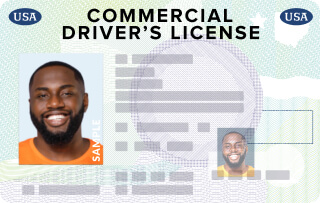- Updated for March 2025
- Based on 2025 OH commercial driver's license manual
Free Ohio CDL Combination Practice Test 2025
Have you been reading the official Ohio Commercial Driver License Manual (Ohio CDL Handbook 2025) to try to pass the official Combination Vehicles knowledge test on operating combination vehicles? Still concerned that you may not pass the test without additional help of some kind? No problem! That’s what we do. Many other aspiring commercial drivers have found themselves in the same situation. That’s why many of them have come here to supplement their reading of the manual with the study tools we offer.
This free Ohio CDL Combination practice test is based on the official manual, just like the official Combination Vehicles knowledge test. The practice test is up to date as of March 2025. Practicing with it will make all the material covered by the test questions easier to remember. To make your learning easier, each of the 25 practice questions comes with a helpful hint and an explanation of the correct answer. The practice questions and answers on this test will assess your knowledge of such topics as combination braking systems, combination driving techniques, coupling and uncoupling, and pre-trip inspections. Stuck on a puzzling question? Our automated assistant can give you a hint. Still answered the question wrong? The assistant can give you an explanation of the correct answer.
There are three classes of Commercial Driver’s License (CDL): Class A, Class B, and Class C. Class A is typically for operating heavy combination vehicles such as semi-trucks and tractor-trailers in Ohio. Passing the Combination Vehicles knowledge test is a virtual necessity for Class A. Otherwise, you won’t even be able to practice driving heavy combination vehicles, which will largely defeat the purpose of obtaining a Class A CDL.
Once you hold a CDL of the appropriate class and all the endorsements you need, you can profit from all the commercial driving opportunities Ohio has to offer. Ohio is the third-largest manufacturing state in the country (behind California and Texas), with over 12,000 manufacturers producing a wide variety of products. Truck drivers are in demand to deliver raw materials to them as well as transport their products. Ohio also employs truck drivers to transport products from its large agricultural sector.
Ohio is also a major Midwest logistics hub. It’s served by such important Interstate truck routes as Interstates 70, 71, 75, 77, and 80/90. Other important truck routes include U.S. Routes 23, 33, and 35 and Ohio Routes 4 and 32. However, winter driving can be difficult, particularly near Lake Erie. Snowstorms, ice, and freezing rain can make driving hazardous on I-90 and I-77 because of lake-effect snow.
- Perfect for first-time and renewal CDL/CLP applicants, and those adding endorsements
- Triple-checked for accuracy
What you need to know

What to expect on the actual OH BMV exam
questions
correct answers to pass
passing score
List of questions (classic view)
- After you lock the kingpin into the fifth wheel, how should you check the connection?
- After you connect the air lines but before you back under the trailer, you should
- Which statement best illustrates the "crack-the-whip" effect?
- When you inspect the landing gear after uncoupling the trailer, where should the tractor be?
- What is the safest way to turn right from a two-way road?
- To drive a triple combination vehicle, you must have
- To prevent a rollover, cargo should be
- Combination vehicles take longer to stop when they are empty than when they are fully loaded, because
- If your vehicle gets stuck on a railroad track, you should
- Low-slung vehicles can be risky at railroad crossings because
- On a double or triple vehicle, which wheels offtrack the most?
- When you're pulling doubles or triples, the shut-off valves should always be
- On a trailer, where is the yellow antilock brake (ABS) malfunction lamp located?
- Even before antilock braking systems (ABS) were required, some vehicles already had them. How can you check if your vehicle has ABS?
- An antilock braking system (ABS) is useful
- After coupling, make sure that the air lines are not crossed. How should you do this?
- During uncoupling, you should disconnect the electrical cable and
- Before you start to uncouple, you must
- You can confirm that air is going to all brakes in your trailers by
- To uncouple a loaded trailer, after the landing gear has made firm contact with the ground, you should
- If the trailer has antilock brakes (ABS) but the tractor doesn't,
- To test the tractor protection valve, charge the trailer air brake system, turn off the engine, and
- If your test of the tractor protection valve is successful,
- The tractor protection valve is designed to close automatically if the air pressure falls into the pressure range specified by the manufacturer, typically
- As part of your vehicle inspection test, if your vehicle is equipped with air brakes and has a trailer, you will inspect the air connections between the truck or tractor and the trailer. Make sure that the ________ are locked in place and free of damage or air leaks.
- Alabama: Test 1 / Test 2
- Alaska: Test 1 / Test 2
- Arizona: Test 1 / Test 2
- Arkansas: Test 1 / Test 2
- California: Test 1 / Test 2
- Colorado: Test 1 / Test 2
- Connecticut: Test 1 / Test 2
- Delaware: Test 1 / Test 2
- District of Columbia: Test 1 / Test 2
- Florida: Test 1 / Test 2
- Georgia: Test 1 / Test 2
- Hawaii: Test 1 / Test 2
- Idaho: Test 1 / Test 2
- Illinois: Test 1 / Test 2
- Indiana: Test 1 / Test 2
- Iowa: Test 1 / Test 2
- Kansas: Test 1 / Test 2
- Kentucky: Test 1 / Test 2
- Louisiana: Test 1 / Test 2
- Maine: Test 1 / Test 2
- Maryland: Test 1 / Test 2
- Massachusetts: Test 1 / Test 2
- Michigan: Test 1 / Test 2
- Minnesota: Test 1 / Test 2
- Mississippi: Test 1 / Test 2
- Missouri: Test 1 / Test 2
- Montana: Test 1 / Test 2
- Nebraska: Test 1 / Test 2
- Nevada: Test 1 / Test 2
- New Hampshire: Test 1 / Test 2
- New Jersey: Test 1 / Test 2
- New Mexico: Test 1 / Test 2
- New York: Test 1 / Test 2
- North Carolina: Test 1 / Test 2
- North Dakota: Test 1 / Test 2
- Ohio: Test 1 / Test 2
- Oklahoma: Test 1 / Test 2
- Oregon: Test 1 / Test 2
- Pennsylvania: Test 1 / Test 2
- Rhode Island: Test 1 / Test 2
- South Carolina: Test 1 / Test 2
- South Dakota: Test 1 / Test 2
- Tennessee: Test 1 / Test 2
- Texas: Test 1 / Test 2
- Utah: Test 1 / Test 2
- Vermont: Test 1 / Test 2
- Virginia: Test 1 / Test 2
- Washington: Test 1 / Test 2
- West Virginia: Test 1 / Test 2
- Wisconsin: Test 1 / Test 2
- Wyoming: Test 1 / Test 2
Your go-to, trusted source
Experience the Driving-Tests differenceOur commitment to accuracy and quality in our practice tests
Explore our rigorous, multi-tiered verification process that ensures each question mirrors the official manual for unparalleled accuracy.

At Driving-Tests.org, we understand the importance of reliable and accurate practice tests to help you prepare for your DMV exam. That's why we've developed a meticulous process to create and continually update our practice questions, ensuring they reflect the most current driving laws and regulations.
Here's an inside look at how we maintain the highest quality in our practice tests.
Content Creation and Verification Process
- Alignment with Official Manuals:
Every question we develop is based on the most recent version of each state's official driving manual. Our team regularly monitors each state DMV's website for the latest updates to ensure our practice tests are always aligned with the most current information. - Community Feedback Integration:
We leverage feedback from our vast community of users to understand which topics are most frequently tested. This helps us focus on the areas that are most relevant and beneficial for your preparation. - Expert Content Creation:
Our in-house editor, Steven, who has extensive experience in driver education, crafts each question with precision. He conducts a thorough review of each question against the official manuals to ensure accuracy. - Rigorous Review Process:
Once Steven has finalized a set of questions, our team conducts a joint review session. This second level of scrutiny involves content accuracy, proofreading, and fact-checking to eliminate any errors. - User Feedback Mechanism:
After a question goes live on our site, we keep the lines of communication open. Each question features a feedback button, inviting users to report any issues or errors. This continuous feedback loop allows us to address and rectify any concerns promptly. - Responsive Updates:
In line with our commitment to accuracy, we quickly update our practice questions to reflect any changes in the DMV manuals. Additionally, we update the free electronic copy of the state's driver's license manuals on our site, typically within a few days after the DMV publishes them.
Our thorough quality control process ensures that you have access to practice tests that are as accurate and up-to-date as possible. We believe in the power of well-prepared drivers and are dedicated to providing you with the best study tools to help you succeed on your DMV exam.
Pass the First Time – Guaranteed
You’re moments away from your results.
Before you view them, see how 1.15 million drivers used Premium to pass faster.
Real Exam-Like Ohio Questions
Get all exam-like questions seen on the real test.
99.06% Pass Rate vs. 49% Average
Most Premium users pass on their first try.
Money-Back Guarantee
We stand behind you until you pass.




